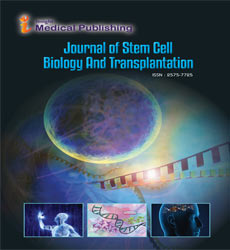ISSN : 2575-7725
Journal of Stem Cell Biology and Transplantation
Pharmacological Optimization of the Conditioning Regimen for Hematopoietic Stem Cell Transplantation
Hematopoietic stem cell transplantation is an effective treatment for a variety of hematological disorders. Its success partly depends on the optimization of the pre-transplant conditioning regimen. To identify an efficacious regimen, we exposed cells to different drug combinations, analyzed their cytotoxicity and identified their molecular mechanisms of interaction using various techniques. We have shown the synergistic cytotoxicity of DNA Alkylating Agents (AA) and Nucleoside Analogs (NA) in leukemia and lymphoma cells and proposed a mechanistic model called the loop of death. Exposure of cells to a nucleoside analog initiates DNA damage resulting in chromatin remodeling and makes genomic DNA more susceptible to DNA alkylation. DNA damage response is then activated and the loop of DNA damage, chromatin remodeling and DNA alkylation continues until the tumor cells commit to apoptosis. Using this model and the [AA+NA] combination as a backbone to identify drugs that may further enhance its anti-tumor activity, we hypothesized that epigenetic modifiers would amplify the loop of death. Indeed, inhibitors of Histone Deacetylases (HDACi) and DNA Methyl Transferases (DNMTi), which facilitate relaxation of chromatin, were found to be synergistic with [AA+NA]. Since active DNA repair may contribute to decreased efficacy of these drug combinations, we also examined the inclusion of DNA repair inhibitors such as olaparib. Addition of olaparib to [AA+NA] caused significant apoptosis by activation of the DNA, damage response, inhibition of PARP activity and DNA repair, production of reactive oxygen species and depolarization of the mitochondrial membranes. Overall, our preclinical and clinical results suggest that the conditioning regimen for HSCT may be optimized by combining drugs that provide synergistic cytotoxicity based on their molecular mechanisms of action. Embryonic stem cells (ES cells or ESCs) are pluripotent stem cells derived from the inner cell mass of a blastocyst, an early-stage pre-implantation embryo. Human embryos reach the blastocyst stage 4–5 days post fertilization, at which time they consist of 50–150 cells. Researchers are currently focusing heavily on the therapeutic potential of embryonic stem cells, with clinical use being the goal for many laboratories. Potential uses include the treatment of diabetes and heart disease. The cells are being studied to be used as clinical therapies models of genetic disorders, and cellular/DNA repair. However, adverse effects in the research and clinical processes such as tumors and unwanted immune responses have also been reported. Cell Replacement Therapies Current research focuses on differentiating ESCs into a variety of cell types for eventual use as Cell Replacement Therapies (CRTs). Some of the cell types that have or are currently being developed include cardiomyocytes (CM), neurons, hepatocytes, bone marrow cells, islet cells and endothelial cells. However, the derivation of such cell types from ESCs is not without obstacles, therefore current research is focused on overcoming these barriers. For example, studies are underway to differentiate ESCs into tissue specific CMs and to eradicate their immature properties that distinguish them from adult CMs.
Abstract
Hematopoietic stem cell transplantation is an effective treatment for a variety of hematological disorders. Its success partly depends on the optimization of the pre-transplant conditioning regimen. To identify an efficacious regimen, we exposed cells to different drug combinations, analyzed their cytotoxicity and identified their molecular mechanisms of interaction using various techniques. We have shown the synergistic cytotoxicity of DNA Alkylating Agents (AA) and Nucleoside Analogs (NA) in leukemia and lymphoma cells and proposed a mechanistic model called the loop of death. Exposure of cells to a nucleoside analog initiates DNA damage resulting in chromatin remodeling and makes genomic DNA more susceptible to DNA alkylation. DNA damage response is then activated and the loop of DNA damage, chromatin remodeling and DNA alkylation continues until the tumor cells commit to apoptosis. Using this model and the [AA+NA] combination as a backbone to identify drugs that may further enhance its anti-tumor activity, we hypothesized that epigenetic modifiers would amplify the loop of death. Indeed, inhibitors of Histone Deacetylases (HDACi) and DNA Methyl Transferases (DNMTi), which facilitate relaxation of chromatin, were found to be synergistic with [AA+NA]. Since active DNA repair may contribute to decreased efficacy of these drug combinations, we also examined the inclusion of DNA repair inhibitors such as olaparib. Addition of olaparib to [AA+NA] caused significant apoptosis by activation of the DNA, damage response, inhibition of PARP activity and DNA repair, production of reactive oxygen species and depolarization of the mitochondrial membranes. Overall, our preclinical and clinical results suggest that the conditioning regimen for HSCT may be optimized by combining drugs that provide synergistic cytotoxicity based on their molecular mechanisms of action. Embryonic stem cells (ES cells or ESCs) are pluripotent stem cells derived from the inner cell mass of a blastocyst, an early-stage pre-implantation embryo. Human embryos reach the blastocyst stage 4–5 days post fertilization, at which time they consist of 50–150 cells.
Open Access Journals
- Aquaculture & Veterinary Science
- Chemistry & Chemical Sciences
- Clinical Sciences
- Engineering
- General Science
- Genetics & Molecular Biology
- Health Care & Nursing
- Immunology & Microbiology
- Materials Science
- Mathematics & Physics
- Medical Sciences
- Neurology & Psychiatry
- Oncology & Cancer Science
- Pharmaceutical Sciences
